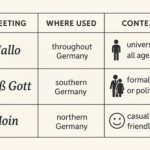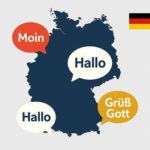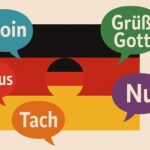
If you travel north of the Main River in Germany, especially toward Hamburg, Bremen, or the North Sea coast, you’ll start to hear one short, friendly word again and again: Moin. It may sound like a shortened version of “morning,” but in Northern Germany, Moin isn’t tied to any particular time of day – it’s a cultural staple, a point of pride, and a local code word for friendliness that cuts across generations.
This article explores the history, usage, and social meaning of Moin – and its variants – to help you greet like a true Norddeutscher.
What Does Moin Mean?
The most common explanation for Moin is that it’s a variation of Morgen (morning). But that’s only partially correct. Many linguists believe Moin comes from the Low German (Plattdeutsch) word moi, meaning “good” or “pleasant.” So technically, Moin means something like “Good [day/time]” – not necessarily “morning.”
This flexible meaning is key to understanding the greeting’s unique position in Northern German culture. You can say it at 8 a.m. or 11 p.m., and no one will blink.
Where You’ll Hear Moin
Moin is used widely in:
- Hamburg
- Lower Saxony
- Bremen
- Schleswig-Holstein
- Northwestern Mecklenburg-Vorpommern
- Northern parts of the Netherlands and Denmark
It’s especially common in coastal towns, fishing villages, and port cities – places where daily interactions are brisk, no-nonsense, and grounded in community rhythm. Moin is efficient, friendly, and easy to say – perfect for a region known for its practical mindset.
For a full overview of greetings across Germany, see:
➡️ Saying Hello in Germany: The Rules of Grüß Gott, Moin, and Hallo
Moin vs. Moin Moin: What’s the Difference?
You’ll often hear both Moin and Moin Moin. They may sound interchangeable, but locals will tell you there’s a difference – sometimes subtle, sometimes fiercely defended.
- Moin: The standard, go-to greeting. Friendly, short, to the point.
- Moin Moin: Slightly more expressive or cheerful. In some places, considered a bit “much” or overly chatty.
In Hamburg, Moin is often preferred for its understated tone. Say Moin Moin in Bremen or Oldenburg, and you may come off as trying too hard.
Fun fact: In East Frisia, saying Moin Moin is sometimes jokingly labeled as “Babbelkram” – excessive talking.
How Locals Use Moin
When to say it:
- Anytime of day – morning, afternoon, or evening
- In shops, cafés, or local businesses
- Passing neighbors or strangers on the street
- Informal workplace settings or among colleagues
- Casual greetings in messages or emails
When not to say it:
- In formal business contexts with non-northerners
- In Southern Germany (unless you enjoy strange looks)
- With people expecting Guten Tag or Hallo in official settings
Variations and Dialectal Forms
Depending on the region and speaker, you might encounter different flavors of Moin:
- Moin Moin! – Friendly, informal double greeting
- Na Moin! – A mix of Na? (how’s it going?) and Moin
- Moinsen! – Youthful, playful variant (popular in memes and online)
- Moini! – Cute or ironic, often used jokingly in texts
These variations are informal and best used among people who already share a casual tone. Try Moinsen in a bakery and you’ll probably get a chuckle – or a confused look if your audience is over 50.
Northern German Identity and the Spirit of Moin
Northern Germans are often stereotyped as cool, reserved, and matter-of-fact – but Moin tells a different story. It’s brief and efficient, yes, but also warm, familiar, and community-minded.
Unlike the South’s Grüß Gott, which carries historical and religious weight, Moin is practical and stripped of pomp. It fits a region known for Protestant roots, maritime tradition, and a no-nonsense worldview.
In some ways, Moin is Northern Germany in a nutshell: efficient, understated, but quietly warm. It’s not about making a big deal out of social pleasantries – it’s about acknowledging each other’s presence with respect and ease.
Is Moin Just for Locals?
Not at all. In fact, using Moin as a visitor or newcomer is often seen as a respectful gesture – as long as it’s used appropriately.
Tips for non-natives:
- Use it in the North only – don’t drop it in Stuttgart or Munich
- Say it with a smile – it’s meant to be friendly
- Match the tone – it’s not loud or dramatic, just casual and calm
- Stick with “Moin” unless you hear locals using variations like Moin Moin
Used correctly, Moin can be an excellent icebreaker – especially in areas where conversation is otherwise minimal.
Moin vs. Grüß Gott: A Contrast in Culture
Where Moin is brief and secular, Grüß Gott is formal and tradition-heavy. Comparing the two highlights the cultural contrast between Northern and Southern Germany:
| Greeting | Region | Time of Day | Tone | Implication |
|---|---|---|---|---|
| Moin | Northern Germany | Any time | Casual | Neutral/friendly |
| Moin Moin | Northern Germany | Any time | Slightly playful | Friendly |
| Grüß Gott | Southern Germany | Daytime | Formal/traditional | Religious roots |
| Hallo | Nationwide | Anytime | Neutral | Generic/modern |
Want to learn how Southern Germans greet each other?
➡️ Grüß Gott! Why Southern Germany Greets Like It’s Still Sunday
What Your Greeting Choice Says About You
Using Moin instantly places you in a specific cultural context. It signals that:
- You’re likely a Northerner – or at least understand the local style
- You value practicality and informality
- You’re familiar with regional German culture
For more on this topic:
➡️ What Your German Greeting Says About You: Identity, Region, and First Impressions
Key Takeaways
- Moin is the go-to greeting in Northern Germany – short, friendly, and used all day
- It’s more than a word – it’s a regional marker and cultural badge
- Moin is informal, secular, and efficient – everything Northern culture values
- Avoid using it in the South or in very formal situations
- Locals appreciate when visitors use it respectfully and sincerely
Moin as a Mindset
In the end, Moin is more than a greeting – it’s an attitude. It reflects Northern Germany’s preference for understatement over flash, steady friendliness over effusive charm, and social ease over formality. If you can say Moin without overthinking it, you’re already halfway to sounding like a local.
Want to understand when Hallo, Guten Tag, or Na? is a better fit? Continue to:
➡️ Hallo, Guten Tag, or Hi? When to Use Formal and Informal German Greetings
Or return to the full overview:
➡️ Saying Hello in Germany: The Rules of Grüß Gott, Moin, and Hallo







